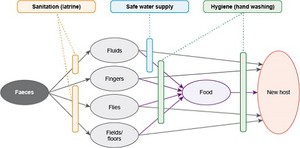Importance of WASH to human health
In developing countries like Ethiopia, most of the diseases affecting the public are related to poor WASH services.
You have already read about trachoma as an example of a WASH-related disease. What other WASH-related diseases do you know of?
You will have your own answer but you may have thought of diarrhoea, typhoid, cholera or intestinal worms and other parasites.
Trachoma is linked to inadequate washing often caused by insufficient quantity of water but many WASH-related diseases are linked to the quality of water. The diseases included in the answer above are caused by people ingesting (eating or drinking) bacteria or other infectious agents, frequently in contaminated water.
For all these diseases, there are three essential components involved in transmission from one person to another. These can be described as the epidemiologic triangle, shown in Figure 1.2. (Epidemiology is the study of the patterns of distribution and causes of disease in a population.) The three components, shown as the three corners of the triangle, are:
- Agent: causes the disease
- Host: has the disease
- Environment: external factors that allow transmission of the disease.

Figure 1.2 The epidemiologic triangle. Preventing diseases means making changes that will break the link in at least one side of the triangle.
All three components are involved in the spread of disease. For example, for trachoma, the agent is the bacteria that cause the infection, the host is the infected person and the environment includes the lack of water for washing. For diseases related to water quality, the agents are the bacteria, viruses and worms that cause disease, the hosts are the infected people, and the environment includes lack of safe water supply and lack of improved sanitation. These environmental conditions allow water to be contaminated with faeces. If the faeces originate from an infected person they will contain the disease-causing agent which can then infect a new host.
There are several different pathways or transmission routes, from faeces to host that are shown in Figure 1.3. This is a pictorial representation of how disease-causing agents spread from faeces through water, food or soil to another person. It is known as the ‘F diagram’ because the main elements all begin with the letter ‘F’, i.e. faeces, fluid, fingers, flies, fields and food. In each transmission route, the infection passes from faeces on the left through to the new host on the right. This is faecal-oral transmission of disease, meaning the infection passes from faeces to mouth (oral is from the Latin for mouth).

Figure 1.3 Pathways of disease transmission, known as the ‘F diagram’. Note how water, sanitation and hygiene are each identified as barriers to transmission at different steps in the transmission route.
In Ethiopia, only 24% of the population use latrines that meet basic standards, and worse still, about 37% of the population practises open defecation (JMP, 2014a). This lack of adequate sanitation obviously makes faecal contamination of the environment and the spread of disease more likely. A 2014 study (WVE, 2014) summarised the impact on young children as follows:
- Diarrhoea is the leading cause of under-5 mortality in Ethiopia, causing 23% of all under-5 deaths (73,341 children per year).
- Around 44% of under-5 children in Ethiopia are stunted (i.e. their height is less than expected for their age), which can be linked to the childhood incidence of diarrhoea and to the lack of WASH services. Important nutrients that the child requires for growth are wiped out through diarrhoea; intestinal parasites take up remaining nutrients and when this scenario continues for some time, the child becomes stunted.
As Figure 1.3 indicates, improving WASH creates barriers to the transmission of disease and has a direct and positive impact on the health and well-being of people.